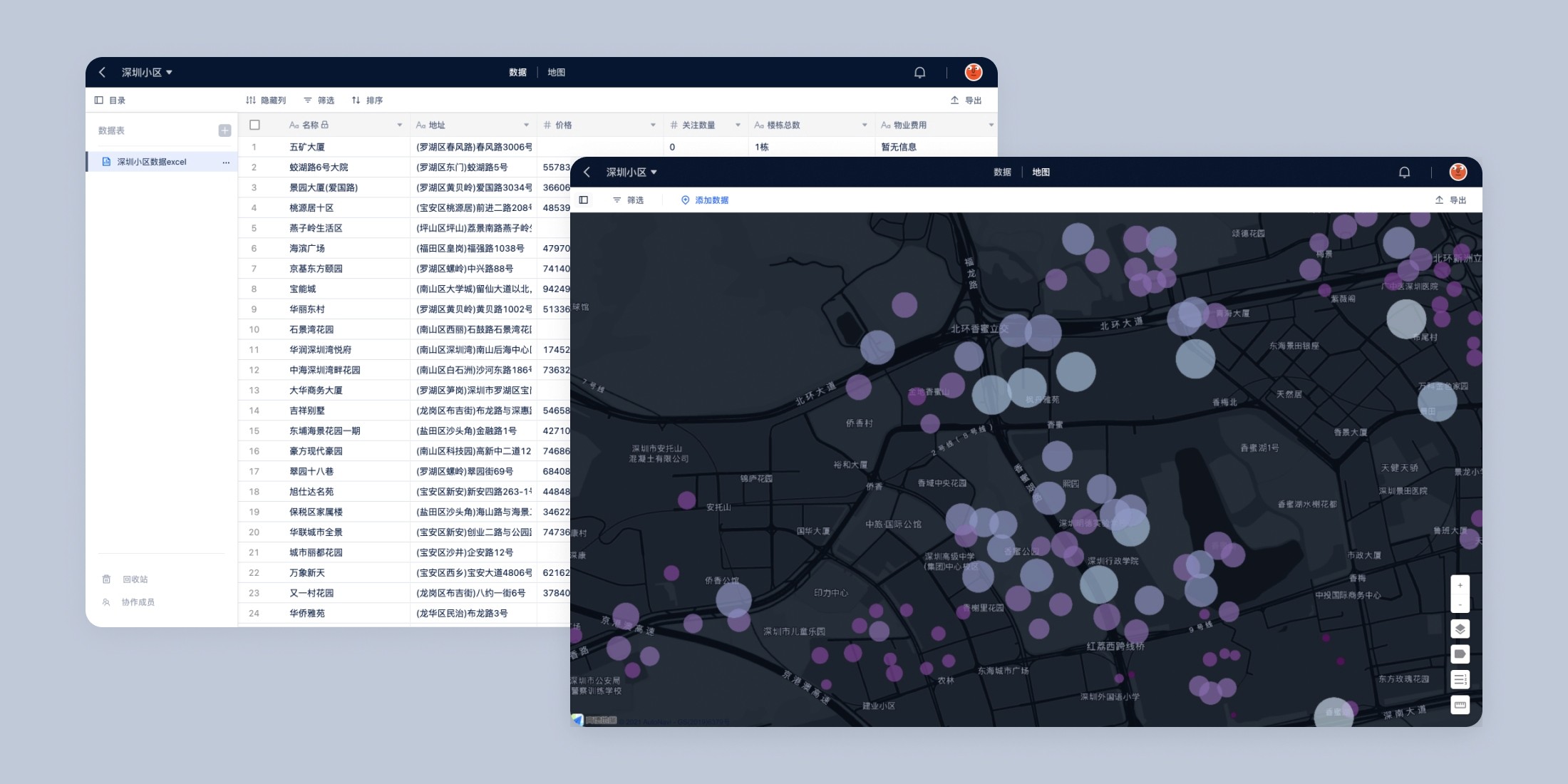MapTable
A no-code tool that allows users to collect, organize, visualize and analyze spatial data. Users can collaborate in real-time.

Project Brief
Role
Lead Product Designer
Timeline
Dec 2020 - Now
PLATFORM
Web, Responsive
Link
http://maptable.com
Contributors
Designer: Weibin
Contributor: Donglei
Contributor: Donglei
MY CONTRIBUTION
Prototyping
Research
UI / UX Design
Product Management
Website Design
Research
UI / UX Design
Product Management
Website Design
Background
QuantUrban has been focusing on developing spatial data products in the past few years, and has had several attempts in this field. I have also participated in the development of products from Mapmiao, Xiao Qu Luo Pan, City Map, to the Guangdong-Hong Kong-Macao Greater Bay Area Report. These products cover various processes of spatial data from collection, collaboration, visualization to data analysis.
However, these products also have problems to different degrees. They are not "standardization", for example, we didn’t find a good solution for different customers’ need to customize fields on demand, compatible with old data and other needs. In the previously developed Mapmiao product, we made a complex form system to meet the customization needs of customers.
However, these products also have problems to different degrees. They are not "standardization", for example, we didn’t find a good solution for different customers’ need to customize fields on demand, compatible with old data and other needs. In the previously developed Mapmiao product, we made a complex form system to meet the customization needs of customers.
The Problems
We have been communicating with our customers during developing products, collecting their feedback, and combining our own experience to conclude the problems we faced at that time.
Several previous products provided solutions for a single scenario, for example, Mapmiao focused on spatial data collection and visualization, and CityMap focused on data collaboration, visualization, and analysis. There is no single product that could completely cover the entire data processing process.
In the past, data analysis relied more on consulting services, and data processing depended on external tools. And our analysis models could not be applied to the products.
Our customers are distributed in different fields such as real estate, planning institutes, educational institutions, retail, etc. Customers' needs in different industries vary greatly and are difficult to standardize. Even different companies in the same industry have different needs on data. New customers always need to customize some fields. So we still need to customize the products for many customer projects, which accounts for a large proportion.
Our customers are primarily in traditional industries, they have accumulated a lot of data in their previous work. A large amount of data is accumulated in the local disks of team members, and members collaborate by transferring files, which is inefficient and easy to make mistakes.
Due to a large amount of historical data of customers, in previous customer projects, it would take a long time to help customers import old data, and this part of the workload often exceeded expectations.
Several previous products provided solutions for a single scenario, for example, Mapmiao focused on spatial data collection and visualization, and CityMap focused on data collaboration, visualization, and analysis. There is no single product that could completely cover the entire data processing process.
In the past, data analysis relied more on consulting services, and data processing depended on external tools. And our analysis models could not be applied to the products.
Our customers are distributed in different fields such as real estate, planning institutes, educational institutions, retail, etc. Customers' needs in different industries vary greatly and are difficult to standardize. Even different companies in the same industry have different needs on data. New customers always need to customize some fields. So we still need to customize the products for many customer projects, which accounts for a large proportion.
Our customers are primarily in traditional industries, they have accumulated a lot of data in their previous work. A large amount of data is accumulated in the local disks of team members, and members collaborate by transferring files, which is inefficient and easy to make mistakes.
Due to a large amount of historical data of customers, in previous customer projects, it would take a long time to help customers import old data, and this part of the workload often exceeded expectations.
Variation in data needs
The data needs of different customers vary greatly and cannot be standardized, requiring the provision of custom fields.
The data needs of different customers vary greatly and cannot be standardized, requiring the provision of custom fields.
High migration cost of old data
High migration costs due to the large amount of customer history data scattered in different local tools.
High migration costs due to the large amount of customer history data scattered in different local tools.
Lack of effective collaboration
Unable to collaborate with multiple people, using Excel and Aowei Map to transfer files, that’s inefficient and more prone to errors.
Unable to collaborate with multiple people, using Excel and Aowei Map to transfer files, that’s inefficient and more prone to errors.
Low level of productization
Part of the work still relies on manual processing, such as adding custom fields, importing old data, and some data analysis work.
Part of the work still relies on manual processing, such as adding custom fields, importing old data, and some data analysis work.